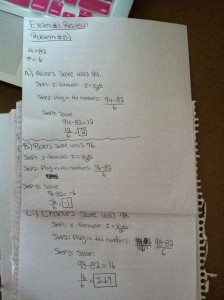8.) The mean score on a Statistics exam was 82, with a standard deviation of 6. Find the standard score (z-score) for each of the students below.
- A.) Alice’s score was 94.
In order to find the Z score, we use the Z formula. This formula is:
Z equals X minus MU (mu is the same as the mean) divided by standard deviation.
We are given a mean score of 82 and a standard deviation of 6.
Our X is also given as Alice’s score of 94.
We now plug the numbers in and solve:
94-82/6
*Remember always follow PEMDAS (parenthesis, exponent, multiplication, division, addition and subtraction.)
94-82=12
12/6=2
Alice’s Z score is: 2
- B.) Bob’s score was 76.
To find Bob’s Z score we use the Z formula as well.
Z equals X minus mu (mu is the same as the mean) divided by standard deviation.
Here our mean and standard deviation are the same but our X is different.
Our mean (which is given) is 82 and our standard deviation (also given) is 6.
Our X is Bob’s score which is 76.
Now we plug our numbers into the formula:
76-82/6
Here PEMDAS should also be used which means we subtract before we divide.
76-82=-6
-6/6=-1
- C.) Charlie’s score was 98.
To find Charlie’s Z score we use the Z formula as well.
Z equals X minus mu (mu is the same as the mean) divided by standard deviation.
Here our mean and standard deviation are the same but our X is different.
Our mean (which is given) is 82 and our standard deviation (also given) is 6.
Our X is Charlie’s score which is 98.
Now we plug our numbers into the formula:
98-82/6
Here PEMDAS should also be used which means we subtract before we divide.
98-82=16
16/6=2.67





Can anyone explain number 9 on the revised review sheet?! Thanks.
Question: how many 5 digit zip codes can be made where all digits are unique? The possible digits are the numbers 0 through 9.
Hi Holly,
If all the digits are unique, it means that once you’ve used a digit you can’t use it again. With this in mind, if we think about choosing 5 digits for our zip code, we have:
10 choices for the first digit (0,1,2,3,4,5,6,7,8,9)
only 9 choices for the second digit (because we can’t repeat the first digit)
only 8 choices for the third digit (because we can’t repeat the first digit or the second digit)
and so on.
The total number is therefore: 10*9*8*7*6